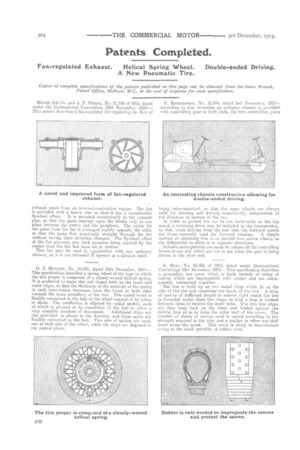Patents Completed.
Page 24

If you've noticed an error in this article please click here to report it so we can fix it.
Fan-regulated Exhaust. Helical Spring Wheel. Double-ended Driving. A New Pneumatic Tire.
Copies of complete specifications of the patents published on this page can be obtained from the Sales Branch, Patent Office, Holborn, W.C., at the cost of sixpence for each specification.
MOTOR-AID CO. and A. F. PRIEST, No. 11,198 of 1915, dated under the International Convention, 25th November, 1914.— This patent describes a fan regulator for regulating the flow of exhaust gases f rum an internal-combustion engine. The fan is provided with a heavy rim, so that' it has a considerable
flywheel effect. It is mounted eccentrically in the exhaust pipe, so that the gases impinge upon the blades only at one place between the centre and the periphery. The outlet for the gases from the fan is arranged exactly opposite the inlet; so that the gases flow practically straight through the fan without having their direction changed. The flywheel effect of the fan prevents any back pressure being exerted by the engine once the fan has been set in motion.
This fan may be used in conjunction with any ordinary silencer, as it is not intended el operate as a silencer itself.
G. J. MURPHY, No. 24,251, dated 18th December, 1914.— This specification describes a spring wheel of the type in which the tire proper is composed of a closely-wound helical spring. It is preferred to make this coil closed both on the inner and outer edges, so that the thickness of the material of the spring in each convolution decreases from the tread at both sides towards the inner periphery of the tire. This coiled tread is flexibly connected to the hub of the wheel instead of by yokes or shoes. The conffection is effected by radial spokes, each of which is pivoted at its connection to the hub to •allow a very complete freedom of movement. Additional stays are also provided, as shown in the drawing, and these again are flexibly connected to the hub. Two lets of spokes are used, one at each side of the wheel, while the stays are disposed in the central plane.
P. RICHARDSON, No. 21,944, dated 3rd November, 1914— According to this invention an ordinary chassis is provided with controlling gear at both ends, the two controlling gears
being interconnected, so that the same wheels are always used for steering and driving respectively, independent of the direction of motion of the car.
In order to permit the car to run backwards on the top speed, a reversing drive may be included in the transmission, so that, when driving from the rear end, the forward speeds are those normally used for forward running. A simple method of obtaining this is to provide two crown wheels on the differential to drive it in opposite directions.
Suitable arrangements are made to release all the controlling levers at one end which are not in use when the gear is being driven at the other end.
A. ROSA, No. 23,356 of 1914, dated under International Convention 10th December, 1913.—This specification describes a pneumta‘tictire cover which is built entirely of strips of canvas which are impregnated with rubber and are subsequently vulcanized together.
The tire is built up on two metal rings which lie at the side of the rim and constitute the heads of the tire. A strip of canvas of sufficient length to extend right round the tire is threaded under these two Tinge, so that a loop is formed between them to receive the inner tube. The two free edges are then bent back on the rings and folded against the central loop sti as to form the outer wall of the cover. The number of sheets of canvas used is varied according to the strength required in the tire, and a leather or other non-skid band forms the tread. This cover is cheap to manufacture owing to the small quantity of rubber ttEed.
























